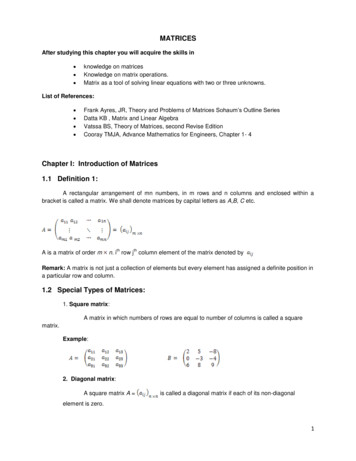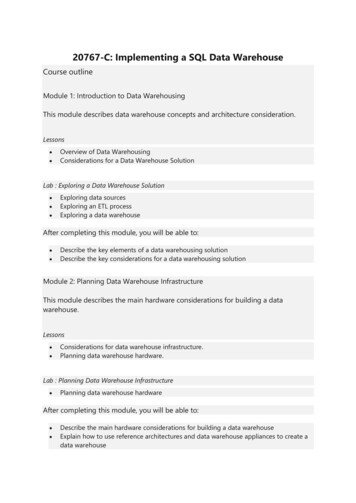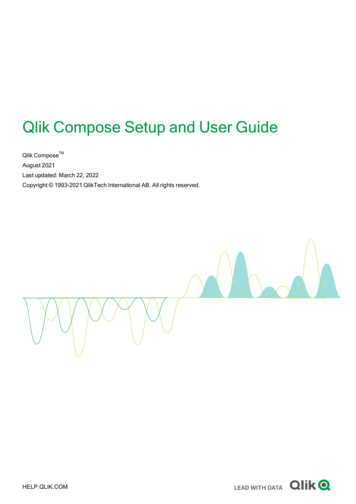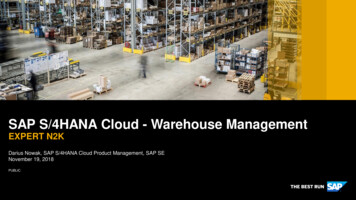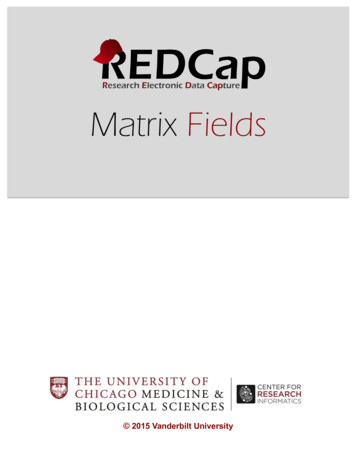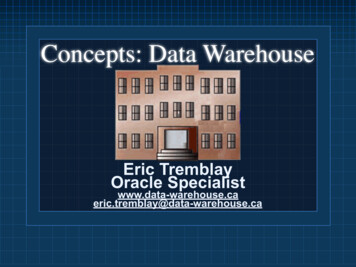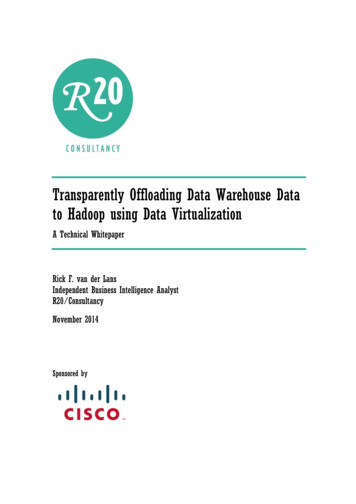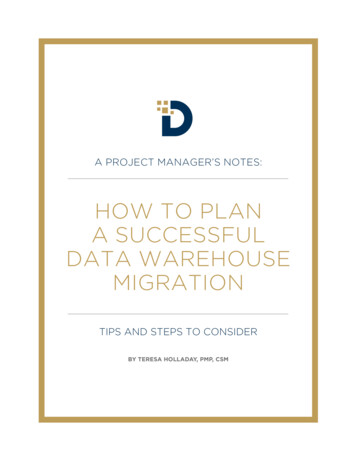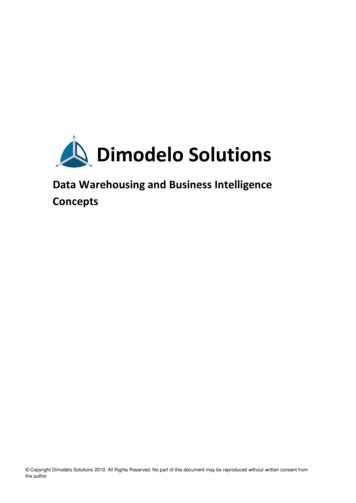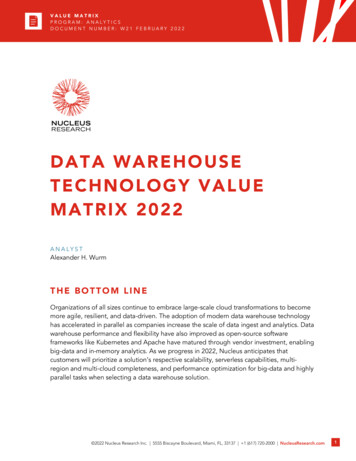
Transcription
VALUE MATRIXPROGRAM: ANALYTICSDOCUMENT NUMBER: W21 FEBRUARY 2022DAT A WARE HOUS ET E CHNOLOG Y VAL UEMAT RIX 2022ANALYSTAlexander H. WurmTHE BOTTOM LINEOrganizations of all sizes continue to embrace large-scale cloud transformations to becomemore agile, resilient, and data-driven. The adoption of modern data warehouse technologyhas accelerated in parallel as companies increase the scale of data ingest and analytics. Datawarehouse performance and flexibility have also improved as open-source softwareframeworks like Kubernetes and Apache have matured through vendor investment, enablingbig-data and in-memory analytics. As we progress in 2022, Nucleus anticipates thatcustomers will prioritize a solution’s respective scalability, serverless capabilities, multiregion and multi-cloud completeness, and performance optimization for big-data and highlyparallel tasks when selecting a data warehouse solution. 2022 Nucleus Research Inc. 5555 Biscayne Boulevard, Miami, FL, 33137 1 (617) 720-2000 NucleusResearch.com1
OVERVIEWData warehouse technology has served as the backbone of most modern cloud applicationsby promising constant availability alongside data durability and correctness. Although datawarehouses typically bring to mind large archaic units of specialized hardware, the massvendor adoption of open-source technologies, such as Kubernetes, Apache Hadoop, andApache Spark, have enabled multi-tenant elastic services yielding incredible flexibility andDocument Number: W21 February 2022NucleusResearch.com2
scalability. Now, data warehouse technologies operate at the confluence of data scienceand networking innovation by housing an organization’s data in a flexible cloud-enabledglobal network while maintaining guarantees of availability, data durability, and correctness.Nucleus defines a data warehouse as a solution that extracts and consolidates data fromvarious data sources, including transaction, operational, and external systems to supportvarious data-intensive SaaS applications. Select data platform and data lake offerings thatmeet these criteria and regularly compete with data warehouse solutions are alsoconsidered in this Value Matrix. The data warehouse market includes solutions of variousscopes and specialties for use cases across select environments or data use-cases. Nucleushas witnessed organizations of all sizes increasingly adopt data warehouse solutions: SMBsfavor cloud-native solutions with intuitive experiences, secure data sharing, and fullymanaged services to accelerate time-to-insight; Large enterprises prioritize the mostperformant platforms optimized to drive low latency with in-memory capabilities for realtime insights and petabyte-scale data processing leveraging massively parallel processing(MPP) architecture for big data tasks.Over the past year, vendors have focused development in five primary areas to differentiatetheir data warehouse offerings: Efficient cluster provisioning and assignment leveragingproprietary ML algorithms, fully managed and serverless capabilities to reduceadministrative oversight and associated costs, multi-cloud and multi-region completeness tomaximize customer flexibility and reduce the risk of cloud and region-specific outages, andservice offerings to streamline implementations and mitigate misconfigured deploymentrisks (Nucleus Research W8 – Database and data warehouse trends for 2022 – January2022).Because data warehouses function as a single source of truth for an organization’s data, datawarehouses are also at the forefront of innovation for machine learning (ML) and artificialintelligence (AI) - based analytics and modeling. As such, vendors compete to deliver selfservice data-science capabilities with select vendors boating native integration withspecialized data science services and others offering collaborative services where users cansecurely share third-party data sets and notebooks to accelerate analytics and modeldevelopment.In this Value Matrix, vendors are positioned according to the relative usability andfunctionality of their respective solutions, as well as the value that customers realized fromeach product’s capabilities (Nucleus Research V67 – Understanding the Value Matrix – April2021) and presented as a snapshot of the current market rather than an empirical ranking ofvendors. The arrows indicate perceived momentum in the indicated direction with respectto usability and functionality. Positioning and momentum are informed primarily byconversations with end-users, along with the most recently released capabilities/featuresand areas of vendor investment.Document Number: W21 February 2022NucleusResearch.com3
LEADERSLeaders in this year’s Value Matrix include Amazon Redshift, Microsoft Azure SynapseAnalytics, Oracle Autonomous Data Warehouse, and Teradata Vantage.AMAZON REDSHIFTAmazon Redshift is a leader in the 2022 edition of the Data Warehouse Technology ValueMatrix. Amazon Redshift can analyze structured and semi-structured data stored across datawarehouses, data lakes, operational databases, and third-party data sets. As a cloud-nativedata warehouse, Amazon Redshift is known for its ease of use and performance at scale withwidespread data accessibility to promote visibility and fast implementations to acceleratereturn on data. Customers leverage Amazon Redshift to shorten time-to-insight withsimplified, managed data access, ingest, and egress, enhancing developer and analystproductivity.Over the past year, Amazon delivered various new capabilities to extend the value of itsdata warehouse solution. In March 2021, Amazon announced the general availability of Amazon Redshift DataSharing. Amazon Redshift data sharing lets customers extend the ease of use,performance, and cost benefits that Amazon Redshift offers in a single cluster tomulti-cluster deployments while being able to share data. It enables granular andfast data access across Amazon Redshift clusters without the need to copy or movedata around. Customers can securely share live data with Amazon Redshift clusters inthe same or different AWS accounts within the same region or across regions. In May 2021, Amazon integrated Redshift ML with Amazon SageMaker to create,train, and deploy machine learning models using SQL statements for use cases suchas churn prediction modeling and fraud risk scoring within user queries and reports.Amazon Redshift ML can also leverage SageMaker Autopilot to automaticallydiscover and tune the appropriate regression, binary, or multi-class classificationmodel. Users can also select specific models, including Xtreme Gradient Boostedtree or Multilayer perceptron, and edit model hyperparameters. In September 2021, Amazon launched Amazon Redshift Query Editor V2 which is aweb-based tool for data analysts, data scientists, and database developers toexplore, analyze, and collaborate on data in Redshift data warehouses and data lake.Users can use Query Editor’s visual interface to create and browse schema andtables, load data, author SQL queries and stored procedures, and visualize queryresults with charts.Document Number: W21 February 2022NucleusResearch.com4
In October 2021, Amazon extended its collaborative capabilities with AWS DataExchange, enabling users to accelerate time to insight by subscribing to third-partydata sets to accelerate the development of queries and analytics. Additionally, AWSData Exchange integration also provides entitlement, billing, and paymentmanagement to help data providers monetize their data. In November 2021, Amazon introduced Amazon Redshift Serverless, whichautomates cluster provisioning and scaling, enhancing IT productivity while drivingcost efficiency with usage-based pricing.Looking ahead, Nucleus expects Amazon Redshift to gain market share as Amazon furtherenhances the intuitiveness of its machine learning capabilities and Redshift Serverless comesout of preview.MICROSOFT AZURE SYNAPSE ANALYTICSMicrosoft Azure Synapse Analytics, formerly Azure SQL Data Warehouse, is a leader in the2022 Data Warehouse Technology Value Matrix. With end-to-end capabilities for dataintegration, data warehousing, and big data analytics, Azure Synapse Analytics offers amanaged elastic data platform for analytics over public, operational, and historic data. AzureSynapse customers can tailor their analytics infrastructure to their processing needs withdedicated and serverless, usage-based pricing options. Azure Synapse Analytics also boastsnative integration with Azure Machine Learning, which also employs a usage-based pricingmodel. This managed environment extends to the platform’s integration with Apache Sparkand eliminates the complexity of cluster provisioning and tuning. Azure Synapse Analyticsuses an enhanced shuffle service with its implementation of Apache Spark to align data andimprove query performance. Azure Synapse further reduces processing latency withdynamic partition pruning to remove unnecessary data during task execution. Microsoft’scloud-native hybrid transaction/analytical processing (HTAP) solution, Azure Synapse Link,drives further speed improvements, enabling continuous analytics over operational data inAzure Cosmos DB without interfering with operational or application workloads.To accelerate time-to-insight, customers can also leverage the Synapse Studio KnowledgeCenter to link sample datasets and add code in the form of sample SQL scripts, notebooks,and pipelines. Customers can expect a faster return on data as the Knowledge Centerexpands with more pipeline, SQL script, and notebook templates. Looking ahead, Nucleusexpects further adoption of Microsoft PowerBI and Azure Synapse Analytics as the vendordevelops and integrates these AI-based data management and analytic capabilities into thevendor’s cloud application suite.Document Number: W21 February 2022NucleusResearch.com5
ORACLE AUTONOMOUS DATA WAREHOUSENucleus recognizes Oracle Autonomous Data Warehouse as a leader in the 2022 edition ofthe Data Warehouse Technology Value Matrix. Autonomous Data warehouse is available fordeployments in Oracle’s cloud and on-premises in customer data centers. As its name mayimply, the Autonomous Data Warehouse offloads the operational complexities involved inmanaging a data warehouse, including provisioning, configuring, securing, performancetuning, patching, and autoscaling processes. This automation enables customers to runvarious analytics tasks without downtime, human intervention, or over-provisioning. TheOracle Autonomous Data Warehouse is also the only solution that uses a convergeddatabase providing built-in support for multimodal data and multiple parallel workloads.Customers can further leverage Oracle’s Hybrid Columnar Compression to achieve maximaldata storage savings. Furthermore, with Oracle’s no-code self-service tools for data loading,data transformation, and data insights, business analysts, data scientists, and developers canaccelerate common workloads and improve productivity. With Oracle’s in-databasealgorithms and model development leveraging an AutoML UI, users can easily analyze andmodel data at its source. Oracle compliments these functionalities with pervasivecapabilities for data security, including data encryption at rest and in motion, regulated dataprotection, security patching, and threat detection. For additional security, customers canuse Oracle Data Safe to conduct continuous monitoring over sensitive data and privilegeduser access.Oracle plans to use its Autonomous Data Warehouse and Autonomous Database solutionsto connect analytics across the vendor’s suite of cloud applications (Nucleus Research W2 –Oracle apps unite via AI-driven analytics – January 2022). To deliver on this crossdepartmental and cross-functional vision, Oracle continues to pour resources into theAutonomous Database to differentiate Oracle Analytics. As this AI-based data managementand analytics becomes developed and integrated into the vendor’s cloud application suite,Nucleus expects increasing adoption with especially strong consideration in competitivedeals for organizations with high processing volumes.TERADATA VANTAGETeradata is a leader in the 2022 edition of the Data Warehouse Technology Value Matrix.Teradata is an enterprise-grade data warehouse with mature workload management,integrated advanced analytics, security, and data access components. Teradata deliversseamless access to data across multi-cloud and hybrid environments with support for AWS,Google, and Microsoft public clouds. Teradata Vantage is also available on virtualizedsoftware using VMware and with Teradata's IntelliFlex hardware. In providing this cohesiveapproach, customers can manage multiple deployments as a single ecosystem, minimizingcosts associated with data movement or replication across environments. Customers canDocument Number: W21 February 2022NucleusResearch.com6
easily migrate between deployment and pricing options with license portability to ensureflexibility and avoid cloud vendor lock-in. With an architecture designed formultidimensional linear scalability, Teradata enables enterprise customers to handle massivedata workloads without any loss to performance. Teradata provides the ability to manageperformance with advanced workload management software to meet SLAs rather thanscaling performance with hardware at additional and often unpredictable cost.Teradata Vantage is a full analytics platform featuring advanced analytics, graph andmachine learning engines, support for R and Python, Vantage Analyst, and the ability tobring your own model to simplify access to complex modeling and analytics. TeradataVantage is also a highly integrated analytics platform, enabling customer organizations toutilize and operationalize their analytics simply within their enterprise applications. Byintegrating with various SaaS applications and BI systems, Vantage enables reporting, staticqueries, ad hoc analysis, active data feeds, operational data warehousing, and complexanalysis in one environment.Over 2021, Teradata delivered various new capabilities and strategic partnerships toenhance the value of Teradata Vantage including: BigQuery connectivity to QueryGrid allowing users to query directly from TeradataVantage to Google BigQuery. AnalyticOps to productize, manage and govern any Vantage Analytic Model whetherit be R, Python, or micro-models based upon SCRIPT table operator, models ormicro-models from Vantage Analytics Library or in-Database SQL-MR, and modelsbuilt externally to Vantage via Bring Your Own Model (BYOM). Cliquing in the Azure Cloud for new as-a-service deployments to significantly reducedowntime from node failures. Teradata also extended this strategic partnership withMicrosoft to integrate Teradata with Power BI. Cloud partner network expansion featuring over 40 new partners including Alteryx,Dataiku, Domino Data, dotData, H2O.ai, IBM-Cognos, MicroStrategy, SAS, andTableau. Plugins for Dataiku allowing its users to create full end-to-end workflows usingVantage in-database R & Python, Teradata’s Advanced SQL Engine, or Dataiku’snative analytic modeling capabilities.Nucleus expects Teradata to improve its placement in future editions of the DataWarehouse Technology Value Matrix as the vendor continues to invest and develop cloudcapabilities to pair with its strong on-premises following. Furthermore, Nucleus expectsincreasing adoption of Teradata Vantage as organizations realize the relative costinefficiency of serverless and usage-based pricing models offered by cloud native datawarehouse vendors who prioritize scalability over resource efficiency.Document Number: W21 February 2022NucleusResearch.com7
EXPERTSExperts in this year’s Value Matrix include Databricks Lakehouse, IBM Db2 Warehouse, andYellowbrick Data.DATABRICKS LAKEHOUSEDatabricks is placed as an expert in the 2022 edition of the Data Warehouse TechnologyValue Matrix as recognized for the Databricks Lakehouse Platform. The DatabricksLakehouse Platform offers the data management and performance capabilities of datawarehouses with the flexible object stores of data lakes. This platform also simplifiesanalytics infrastructures by bringing analytics, data science, and machine learning workloadstogether under one cohesive environment. A key differentiator of the Databricks Lakehouseinvolves its Delta Lake foundation which provides a unified ecosystem for management andgovernance of structured, semi-structured, and unstructured data optimized for costefficiency and scalability. Customers can also leverage Delta Lake to perform open protocolsecure data sharing with Delta Sharing. This significantly enhances collaboration within theuser ecosystem as organizations can securely share data assets across their partner network.Because of Databrick’s focus on open source and open protocol, customers can benefitfrom a collaborative developer ecosystem and maintain flexibility with escape hatches toavoid vendor lock-in. With the vendors DNA in Apache Spark, Databricks is well suited forlarge scale data analytics with robust capabilities for data engineering and automatedmachine learning capabilities leveraging Managed MLflow. Databricks also features “glassbox” AutoML functionality allowing users to quickly generate baseline models andnotebooks with a low-code approach.Databricks has continued to invest in its Data Lakehouse Platform over the past year. In August 2021, Databricks announced 1.6 billion in Series H funding to accelerateadoption of data lakehouse architectures. In October 2021, Databricks acquired German data science startup 8080 labs toenable rapid and intuitive data exploration and transformation with the startup’slow/no-code data science tool, bamboolib. In January 2022, Databricks launched its data lakehouse for retail and consumergoods to address common problems for customers in those industries.Nucleus anticipates Databricks will capture market share from other data warehouse vendorsfor clients prioritizing data science functionality. As Databricks improves the intuitiveness ofits data science with further investments into low/no-code capabilities and industry-specificdata lakehouses, customers can expect increasing value from their Databricks deploymentsas represented by improved positioning along both the usability axis.Document Number: W21 February 2022NucleusResearch.com8
IBM DB2 WAREHOUSEIBM Db2 is placed as an expert in the 2022 edition of the Data Warehouse TechnologyValue Matrix. With its Db2 Warehouse offering, IBM delivers a preconfigured datawarehouse deployable to private clouds and other Docker-container-based infrastructure.IBM Db2 Warehouse is ideal for customers enlisting hybrid cloud approaches as it pairs theflexibility of a cloud environment with thorough data and security controls. This focusenables customers to progressively transition sensitive data to the cloud with increasingconsideration in competitive deals as the security requirements and complexity of thecustomer’s cloud transformation scale. IBM Db2 Warehouse boasts a wide range offunctionality with support for both SMP and MPP system designs, built-in analytics andmachine learning, and automated elastic scaling. IBM Db2 Warehouse is also highlyintegrated with Apache Spark, further streamlining data analytics and machine learning atscale.Over the past year, IBM has delivered various new and extended capabilities to the Db 2Warehouse to enhance customer value. In July 2021, IBM integrated Db2 Warehouse with IBM Key Protect to help usersmanage their keys, improving control over data encryption within the system. In September 2021, IBM released a panel detailing the status of activity, locking,utility, and statistics event monitors for a given database connection. IBM also addedsupport for workload customization on activity and statistic event monitors. In January 2022, IBM extended support for indexes, table spaces, and buffer poolsand increased storage capacity to 240 TB.With this focus on data controls and security IBM has built confidence in its cloud and Db2Warehouse, unlocking a new area of cloud migrations traditionally limited by data securityrequirements or risk thresholds. Furthermore, IBM Db2 Warehouse’s differentiatedcommitment to hybrid cloud customers allows the vendor to build a moat around itsposition as the leading provider of solutions and services geared towards hybrid cloudapproaches.YELLOWBRICK DATAYellowbrick Data is an expert in this year’s edition of the Data Warehouse Technology ValueMatrix. Yellowbrick Cloud Data Warehouse leverages PostgreSQL alongside MPParchitecture to provide real-time insights from data at any scale. Yellowbrick markets itself asa Data Warehouse for Distributed Data Clouds and, as such, can be deployed anywhere,including private data centers, public clouds, and container environments like Kubernetes atthe edge. Yellowbrick serves a diverse array of industries, including financial services,Document Number: W21 February 2022NucleusResearch.com9
insurance, telecommunications, manufacturing, healthcare, and retail. Yellowbrick managesdata in a hybrid row and column store to provide optimal performance for low-latency tasksand ad-hoc queries. Yellowbrick further appeals to customers leveraging private cloudenvironments with its proprietary Andromeda architecture, featuring AMD 64-coreprocessors and “Kalidah” scan accelerators to optimize performance and resourceconsumption efficiency. All data warehousing is managed by Yellowbrick Data Manager, a“single pane of glass” for unified data control across distributed cloud environments.Yellowbrick Data Manager also allows users to monitor deployments, browse and load datathrough a web browser, and write/edit SQL. Yellowbrick customers noted several key driversof adoption, including the platform’s capabilities for live processing of streaming data andefficient batched processing, and flexibility between cloud and on-premises usage.Throughout the past year, Yellowbrick enhanced customer value with new partnerships andinvestments into new capabilities. In April 2021, Yellowbrick Data introduced its data warehouse designed fordistributed clouds to support emerging IoT and edge analytics use cases whileseamlessly connecting private data centers and public clouds. In November 2021, Yellowbrick Data announced series C1 funding of 75 million toaccelerate the enterprise adoption of its cloud data warehouse and fund innovationin a highly iterative space. In February 2022, Yellowbrick Data announced its partnership with NipponInformation and Communication Corporation (NI C) in Japan to continue globalexpansion, as well as to underscore the value of NI C’s data to servetelecommunication, transportation, and banking institutions.Nucleus expects Yellowbrick Data to improve its positioning in future editions of the DataWarehouse Technology Value Matrix as Yellowbrick Data becomes further integrated withvarious public cloud providers. Nucleus also anticipates customer adoption to accelerate asYellowbrick Data begins offering serverless pricing options to extend the competitiveadvantage of Yellowbrick Data’s differentiated architecture and networking technologies.FACILITATORSFacilitators in this year’s Value Matrix include Google BigQuery, SAP Data WarehouseCloud, and Snowflake.Document Number: W21 February 2022NucleusResearch.com10
GOOGLE BIGQUERYNucleus places Google BigQuery as a facilitator in the 2022 edition of the Data WarehouseTechnology Value Matrix. With Google BigQuery, users can analyze structured and semistructured data using SQL, leveraging a serverless approach within a fully managed multicloud environment. Google BigQuery serves a variety of industries, including retail,manufacturing, automotive, energy, healthcare, media, telecommunications, governmentand public sector, and financial services. Customers can ingest data into BigQuery throughvarious modalities, including batch loading, data streaming, and live connectors with thirdparty applications. Customers can also run advanced analytics leveraging BigQuery ML,including regression, K-means clustering, matrix factorization, gradient boosted decisiontrees, and deep neural networks. Google pairs these capabilities for petabyte-scale analyticswith BigQuery BI Engine’s capabilities for in-memory analytics to enable latency-optimizedquery processing integrated with popular BI solutions, including Looker, Tableau, GoogleData Studio, and Power BI. Google BigQuery also supports geospatial analytics withBigQuery GIS allowing users to integrate location data for a more comprehensiveunderstanding on how geography impacts operations. Google BigQuery is central toGoogle’s vision of supporting customers’ Data Clouds by unifying their data lifecycle acrossdatabases, data analytics, BI, and AI use cases.Throughout 2021, Google delivered various new and extended functionalities to enhancethe value of BigQuery. In May 2021, Google announced Analytics Hub for data access and sharing. Googlealso announced Dataplex, an intelligent data mesh that unifies data managementand governance across customer data lakes, data warehouses, and data marts. In July 2021, Google made BigQuery Omni generally available, allowing customersto perform multi-cloud analytics without having to move or replicate data storedwithin AWS S3 or Azure blob storage. In August 2021, Google introduced Cloud Spanner federated queries with BigQueryallowing users to query data held within Spanner in real-time without the need fordata replication or new ETL pipelines to move data. In October 2021, Google announced support for Apache Spark on Google Cloudfeaturing serverless autoscaling to accelerate big data analytics, deliver usage-basedpricing and save IT time previously spent managing Spark clusters. In January 2022, Google announced the general availability of Explainable AI inBigQuery to help users understand the results of their machine-learning models.Document Number: W21 February 2022NucleusResearch.com11
Google also announced support for new governance capabilities, such as field-levelencryption, SQL workload management capabilities, and automatic data lossprevention (DLP) with Google Cloud DLP.Looking ahead, Nucleus expects improved positioning of Google BigQuery, as the vendorcontinues to extend data science and governance capabilities alongside investment intonew networking technologies and secured lakehouse architecture.SAP DATA WAREHOUSE CLOUDSAP Data Warehouse Cloud is placed as a facilitator in the 2022 edition of the DataWarehouse Technology Value Matrix. With SAP Data Warehouse Cloud, the vendor deliversa multi-cloud solution with data integration, database, data warehouse, and analyticscapabilities built on the SAP HANA Cloud. SAP represents a comprehensive data warehousesolution with capabilities for governance, data modeling, business modeling, repository, andsecurity services. SAP offers multiple on-premises, hybrid, and cloud deployment optionswith a choice of public and private environments for cloud deployments. Customers can alsoconnect these environments across multi-cloud and on-premise data repositories topreserve business context across systems. Customers also gain intuitive ease-of-use withSAP’s virtual workspace and no-code environment for data connection, modeling,visualization, and secure sharing. To enable real-time analytics, SAP supports in-memoryprocessing of structured, unstructured, and geospatial data. SAP also offers a pre-integrateddatabase, data warehouse, data lake, and analytics to accelerate implementations. SAP DataWarehouse Cloud is also a fully managed service minimizing ongoing complexity forbusiness and IT post-deployment.SAP continued to develop new functionalities for its SAP Data Warehouse Cloud throughoutthe past year, including: SAP BW Bridge, allowing users to import BW Bridge data models into SAP DataWarehouse Cloud and benefit from other BW functionality within a flexible publiccloud environment. Intelligent Lookup to join any two entities with some sort of semantic relationshipusing a no-code UI. Extended flexibility in the Data Flow to import excel files from remote file storageand configure the worksheet to be used.Nucleus anticipates SAP Data Warehouse Cloud to continue to grow, leveraging theplatform’s integrated capabilities to power hybrid and complex multi-cloud environments.Looking forward, we expect SAP to further invest in the usability of its Data WarehouseCloud with capabilities for serverless pricing and secure data sharing.Document Number: W21 February 2022NucleusResearch.com12
SNOWFLAKE DATA CLOUDNucleus recognizes Snowflake as a facilitator in the 2022 edition of the Data WarehouseTechnology Value Matrix. Snowflake sets its ambitions beyond multi-cloud, aspiring for afully cross-cloud data platform. Snowflake achieves this by leveraging Secure Data Sharingto manage data access through Snowflake’s unique services layer and metadata store toprovide internal departments, customers, and business partners with a read-only databasecontaining shared data that does not contribute to a client’s data storage charges. Thiscapability also extends to live governed data enabling collaborative insights in real-time.Snowflake Data Cloud offers a completely serverless architecture allowing customers toeasily scale up or scale out their data warehouse instances and pay based on usage. Theseserverless capabilities also save IT time by internally managing capacity planning, resourceprovisioning, and server maintenance. Although this serverless approach grants usagebased pricing, Snowflake does not scale computational resources in linear increments,rather opting for exponential increments (2n). For example, if a compute task required fiveGPUs, Snowflake would assign the user eight GPUs. Snowflake’s usage-based pricing modelcan lead customers to accrue usage costs that exceed the customer’s resource utilization.Snowflake
the Data Warehouse Technology Value Matrix. Autonomous Data warehouse is available for deployments in Oracle's cloud and on-premises in customer data centers. As its name may imply, the Autonomous Data Warehouse offloads the operational complexities involved in managing a data warehouse, including provisioning, configuring, securing, performance


